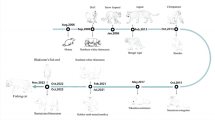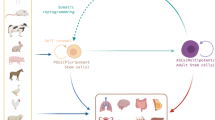Abstract
Domestic animal embryonic stem cells are of potentially big value in transgenic research and studies of lineage commitment and development. Unfortunately, despite many efforts, validated embryonic stem cell lines in species other than mice and primates are yet to be isolated. Here we review some factors that might help to explain why derivation of domestic animal embryonic stem cells is still unsuccessful.



Similar content being viewed by others
References
Evans, M. J., & Kaufman, M. H. (1981). Establishment in culture of pluripotent cells form mouse embryo. Nature, 292, 154–156. doi:10.1038/292154a0.
Martin, G. R. (1981). Isolation of a pluripotent cell line from early mouse embryos cultured in medium conditioned by teratocarcinoma stem cells. Proceedings of the National Academy of Sciences of the United States of America, 78(12), 7634–7638. doi:10.1073/pnas.78.12.7634.
Capecchi, M. R. (1989). Altering the genome by homologous recombination. Science, 244(4910), 1288–1292. doi:10.1126/science.2660260.
Bradley, A. (1987). Production and analysis of chimaeric mice. In E. J. Robertson (Ed.), Teratocarcionomas and embryonic stem cells: A practical approach (pp. 113–151). Oxford: IRL.
Keefer, C. L., Pant, D., Blomberg, L., & Talbot, N. C. (2007). Challenges and prospects for the establishment of embryonic stem cell lines of domestic ungulates. Animal Reproduction Science, 98, 147–168. doi:10.1016/j.anireprosci.2006.10.009.
Renard, J. P., Maruotti, J., Jouneau, A., & Vignon, X. (2007). Nuclear reprogramming and pluripotency of embryonic cells: Application to the isolation of embryonic stem cells in farm animals. Theriogenology, 68(Suppl 1), S196–S205. doi:10.1016/j.theriogenology.2007.05.060.
Brevini, T. A., Antonini, S., Pennarossa, G., & Gandolfi, F. (2008). Recent progress in embryonic stem cell research and its application in domestic species. Reproduction in Domestic Animals, 43(Suppl 2), 193–199. doi:10.1111/j.1439-0531.2008.01161.x.
Muñoz, M., Díez, C., Caamaño, J. N., Jouneau, A., Hue, I., & Gómez, E. (2008). Embryonic stem cells in cattle. Reproduction in Domestic Animals, 43(Suppl 4), 32–37. doi:10.1111/j.1439-0531.2008.01229.x.
Talbot, N. C., & Blomberg, L. A. (2008). The pursuit of ES cell lines of domesticated ungulates. Stem Cell Reviews, 4(3), 235–254. doi:10.1007/s12015-008-9026-0.
Wei, C. L., Miura, T., Robson, P., Lim, S. K., Xu, X. Q., Lee, M. Y., et al. (2005). Transcriptome profiling of human and murine ESCs identifies divergent paths required to maintain the stem cell state. Stem Cells, 23(2), 166–85. doi:10.1634/stemcells.2004-0162.
Sun, Y., Li, H., Liu, Y., Shin, S., Mattson, M. P., Rao, M. S., et al. (2007). Cross-species transcriptional profiles establish a functional portrait of embryonic stem cells. Genomics, 89, 22–35. doi:10.1016/j.ygeno.2006.09.010.
Brook, F. A., & Gardner, R. L. (1997). The origin and efficient derivation of embryonic stem cells in the mouse. Proceedings of the National Academy of the United States of America, 94(11), 5709–5712. doi:10.1073/pnas.94.11.5709.
Kuijk, E. W., Du Puy, L., Van Tol, H. T., Oei, C. H., Haagsman, H. P., Colenbrander, B., et al. (2008). Differences in early lineage segregation between mammals. Developmental Dynamics, 237(4), 918–927. doi:10.1002/dvdy.21480.
Kirchhof, N., Carnwath, J. W., Lemme, E., Anastassiadis, K., Schöler, H., & Niemann, H. (2000). Expression pattern of Oct-4 in preimplantation embryos of different species. Biology of Reproduction, 63(6), 1698–1705.
Henderson, J. K., Draper, J. S., Baillie, H. S., Fishel, S., Thomson, J. A., Moore, H., et al. (2002). Preimplantation human embryos and embryonic stem cells show comparable expression of stage-specific embryonic antigens. Stem Cells, 20, 329–337. doi:10.1634/stemcells.20-4-329.
Nichols, J., Zevnik, B., Anastassiadis, K., Niwa, H., Klewe-Nebenius, D., Chambers, I., et al. (1998). Formation of pluripotent stem cells in the mammalian embryo depends on the POU transcription factor Oct4. Cell, 95(3), 379–391. doi:10.1016/S0092-8674(00)81769-9.
Muñoz, M., Rodriguez, A., De Frutos, C., Caamaño, J. N., Díez, C., Facal, N., et al. (2008). Convencional pluripotency markers are unspecific for bovine embryonic derived cell-lines. Theriogenology, 69(9), 1159–1164. doi:10.1016/j.theriogenology.2008.02.014.
Degrelle, S. A., Campion, E., Cabau, C., Piumi, F., Reinaud, P., Richard, C., et al. (2005). Molecular evidence for a critical period in mural trophoblast development in bovine blastocysts. Developments in Biologicals, 288(2), 448–460. doi:10.1016/j.ydbio.2005.09.043.
Thomson, J. A., Itskovitz-Eldor, J., Shapiro, S. S., Waknitz, M. A., Swiergiel, J. J., Marshall, V. S., et al. (1998). Embryonic stem cell lines derived from human blastocysts. Science, 282(5391), 1145–1147. Erratum in: Science 1998; 282. 5395 1827. doi:10.1126/science.282.5391.1145.
Xu, R. H., Chen, X., Li, D. S., Li, R., Addicks, G. C., Glennon, C., et al. (2002). BMP4 initiates human embryonic stem cell differentiation to trophoblast. Nature Biotechnology, 20(12), 1261–1264. doi:10.1038/nbt761.
Betteridge, K. J., & Fléchon, J. E. (1988). The anatomy and physiology of pre-attachment bovine embryos. Theriogenology, 29(1), 155–187. doi:10.1016/0093-691X(88)90038-6.
Acknowledgments
Dr M. Muñoz and I. Molina are supported by grants from the Spanish Ministry of Science and Innovation.
B. Trigal is supported by a grant from the Caja de Ahorros of Asturias.
This work is supported by Spanish Ministry of Science and Innovation (Project AGL2005-04479)
Author information
Authors and Affiliations
Corresponding author
Rights and permissions
About this article
Cite this article
Muñoz, M., Trigal, B., Molina, I. et al. Constraints to Progress in Embryonic Stem Cells from Domestic Species. Stem Cell Rev and Rep 5, 6–9 (2009). https://doi.org/10.1007/s12015-009-9052-6
Received:
Accepted:
Published:
Issue Date:
DOI: https://doi.org/10.1007/s12015-009-9052-6




